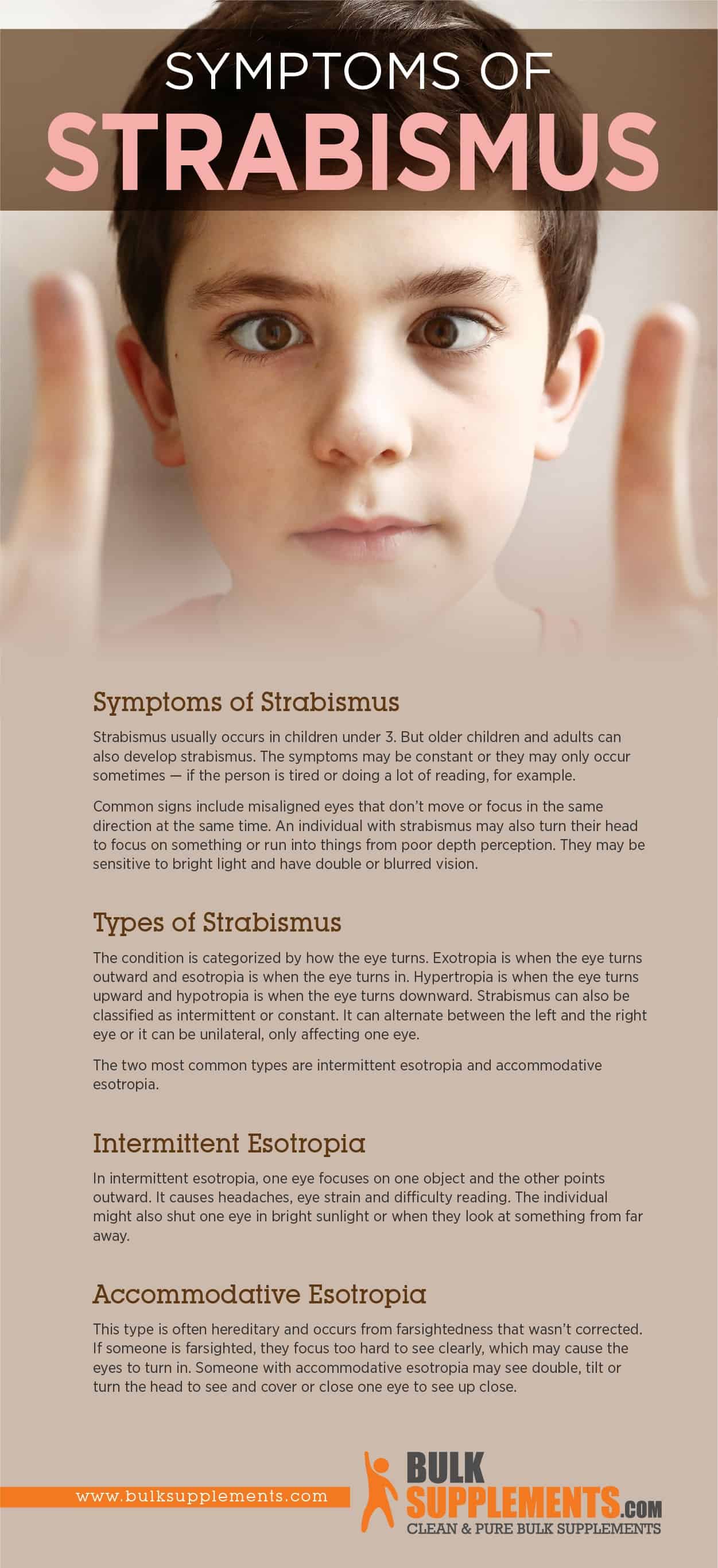What is Strabismus?
Commonly known as “crossed eyes,” strabismus is a condition characterized by misalignment in the eyes. For example, one eye may point out, in, down or up while the other eye looks straight ahead. It affects up to 13 million people in the United States, about 4 percent of the population (x, x).
There are six extraocular muscles that control eye and eyelid movement (x). Sometimes there is an abnormality in the way the muscles and nerves function. When they don’t work together, the eyes can’t focus in one direction at the same time (x).
Fortunately, many cases of crossed eyes can be treated to minimize vision problems and correct misalignment (x).
Symptoms of Strabismus
Strabismus usually occurs in children under 3. But older children and adults can also develop strabismus (x). The symptoms may be constant or they may only occur sometimes — if the person is tired or doing a lot of reading, for example (x).
Common signs include misaligned eyes that don’t move or focus in the same direction at the same time. An individual with strabismus may also turn their head to focus on something or run into things from poor depth perception. They may be sensitive to bright light and have double or blurred vision (x, x).
Types of Strabismus
The condition is categorized by how the eye turns. Exotropia is when the eye turns outward and esotropia is when the eye turns in. Hypertropia is when the eye turns upward and hypotropia is when the eye turns downward. Strabismus can also be classified as intermittent or constant. It can alternate between the left and the right eye or it can be unilateral, only affecting one eye (x).
The two most common types are intermittent esotropia and accommodative esotropia (x, x).
Intermittent Esotropia
In intermittent esotropia, one eye focuses on one object and the other points outward. It causes headaches, eye strain and difficulty reading. The individual might also shut one eye in bright sunlight or when they look at something from far away.
Accommodative Esotropia
This type is often hereditary and occurs from farsightedness that wasn’t corrected. If someone is farsighted, they focus too hard to see clearly, which may cause the eyes to turn in. Someone with accommodative esotropia may see double, tilt or turn the head to see and cover or close one eye to see up close.

Causes of Strabismus
Each eye is surrounded by six different muscles that work together to focus both eyes on one thing at a time. But in strabismus, the muscles don’t work as a team. As one eye focuses on one thing, the other focuses on something else. When this happens, the brain receives one image from each eye. But it learns to ignore one of them to avoid confusion (x, x, x).
Because the brain ignores one of the images, it causes vision loss in one eye called amblyopia — or “lazy eye” — if strabismus isn’t treated. Fifty percent of children with strabismus also have amblyopia (x). However, sometimes people can have amblyopia first and it can cause strabismus (x).
Most cases of childhood strabismus do not have an identifiable cause, but there are risk factors.
Twin studies suggest a genetic component that can make some individuals more likely to develop it than others (x). Farsightedness can also lead to strabismus, especially in children. Without treatment, it can cause the eyes to cross inward because they strain to see clearly (x).
Other medical conditions can also raise the risk of strabismus (x). In children, it is linked to cerebral palsy (x), Apert syndrome (x), trisomy 18 (x) or Noonan syndrome (x). In adults, strabismus may develop as a result of botulism, diabetes, stroke, Graves’ disease (x) or vision loss from an eye injury or disease. Both children and adults who experience a traumatic brain injury are at risk for developing strabismus (x).
Strabismus Treatment
An early diagnosis will allow for more effective treatment. Treatment is most effective if the patient is younger than 6 or the patient can suffer permanent vision loss. By age 8, the vision matures and doesn’t respond as well to treatment. However, treatment has been successful in older patients (x, x).
To correct strabismus, treatment aims to strengthen the affected eye, combining different methods or using them alone (x, x, x).
Glasses
If farsighted vision is causing the eyes to cross, prescription glasses can often correct it.
Prism Lenses
Prism lenses bend the light as it hits the eye and helps it focus without turning.
Patching
Patients may have to wear an eye patch to treat amblyopia. By correcting the vision, the patch can also help correct misalignment in the eye.
Medication
Ointments or eye drops can weaken the muscles in the stronger eye so that the person has to use their weaker eye more and strengthen the muscles. Depending on the situation, a doctor may prescribe medications in place of surgery or along with it.
Vision Therapy
An optometrist may develop a plan of visual activities that will train the eyes to work more effectively with the brain to improve eye focus, coordination and movement.
Orthoptics
While vision therapy uses visual exercises, orthoptics are physical eye exercises that direct eye movement, and can help your eyes work better together.
Eye Muscle Surgery
Surgical procedures reposition the muscles around the eye so that it is aligned correctly. Usually the patient goes through vision therapy after surgery to work on coordination so that the eyes don’t cross again.
If strabismus is left untreated, it can result in vision loss. But if it is diagnosed early, treatment is often successful.
Supplements for Eye Health
Supplements can be vital to improve vision and promote eye health by adding to the nutrients from your diet.
Lutein Powder
Vegetables contain large quantities of lutein, which belongs to the carotenoid family. It is often used as an antioxidant and to promote eye health. The recommended dosage is 100 to 400 mg once a day.
Zeaxanthin 5% Powder
Zeaxanthin belongs to the carotenoid family and gives plants like paprika and marigold their rich color. It may benefit eye health and provide natural pigmentation. Take 100 mg of zeaxanthin powder once or twice a day.
Bilberry Extract Powder
Bilberry contains antioxidants that support cardiovascular and circulatory health. The recommended dosage is 400 mg once or twice a day with food, unless a physician suggests otherwise.
Glycine Powder
Glycine is an antioxidant as well as an amino acid. It’s essential for energy production and muscle maintenance. Take 1,000 mg up to three times a day, depending on the preferred effect.
Vitamin A
Fish, eggs, milk, vegetables and fruit contain beta-carotene, which is converted into Vitamin A. It is often used in cosmetics and promotes vision and immune function (x).
Vitamin C
Our bodies do not make Vitamin C naturally, so it’s important to supplement it. It stimulates the immune system and all of the body’s cells depend on it, including the ones in the eyes (x). Take 1,000 mg of vitamin C once a day.
Vitamin E
This fat-soluble antioxidant promotes healthy hair and skin and helps prevent cataracts (x). Take 500 to 1,000 milligrams of Vitamin E powder daily with meals.
Zinc Gluconate Powder
This essential mineral contributes to immune, bone, heart and eye health. Zinc gluconate may also promote wound healing. Take 225 to 450 milligrams of zinc gluconate powder 1-3 times daily, or as suggested by your physician.
Omega-3-6-9 Softgels
Fatty acids benefit mood and heart health, as well as lower inflammation. Take three omega-3-6-9 softgels one to two times a day.
The Bottom Line
Strabismus, or crossed eyes, develops when the eyes don’t align. It can develop at any age, but it’s most prevalent in babies and young children. About 4 percent of the population has strabismus.
Symptoms may come and go or they may be constant. The condition causes poor depth perception, uncoordinated eye movements, double vision and vision loss. Strabismus develops when the brain and the eye muscles fail to connect. It may accompany certain conditions, including stroke, diabetes, thyroid disorders, Grave’s disease or cerebral palsy. Brain injuries can also cause strabismus.
Treatment options vary, depending on the cause and form of strabismus. But it aims to align the eyes and restore or preserve vision. Strabismus treatment is most effective in children under 6. Patients should treat the condition as soon as possible because it can cause permanent vision damage.


